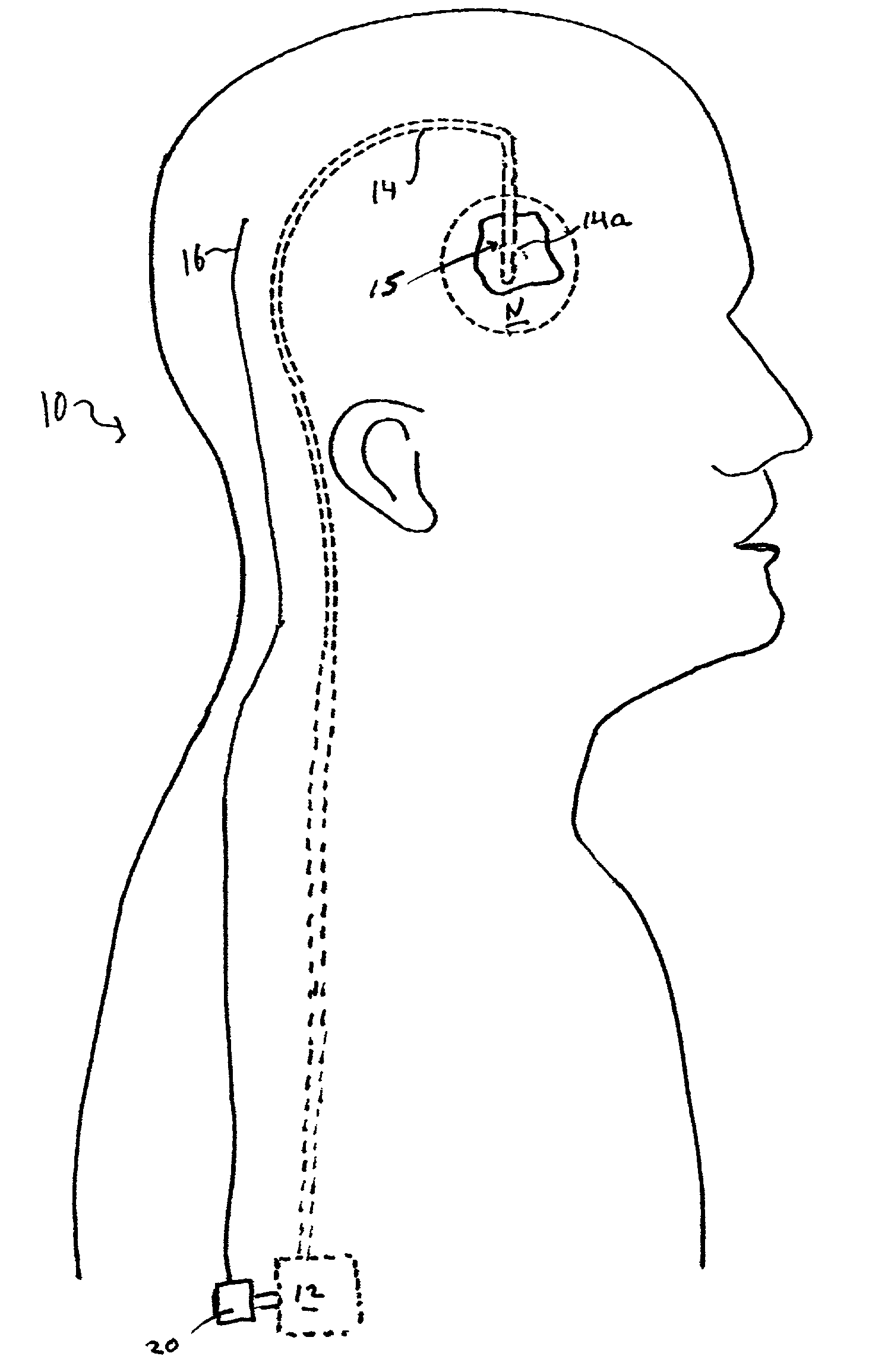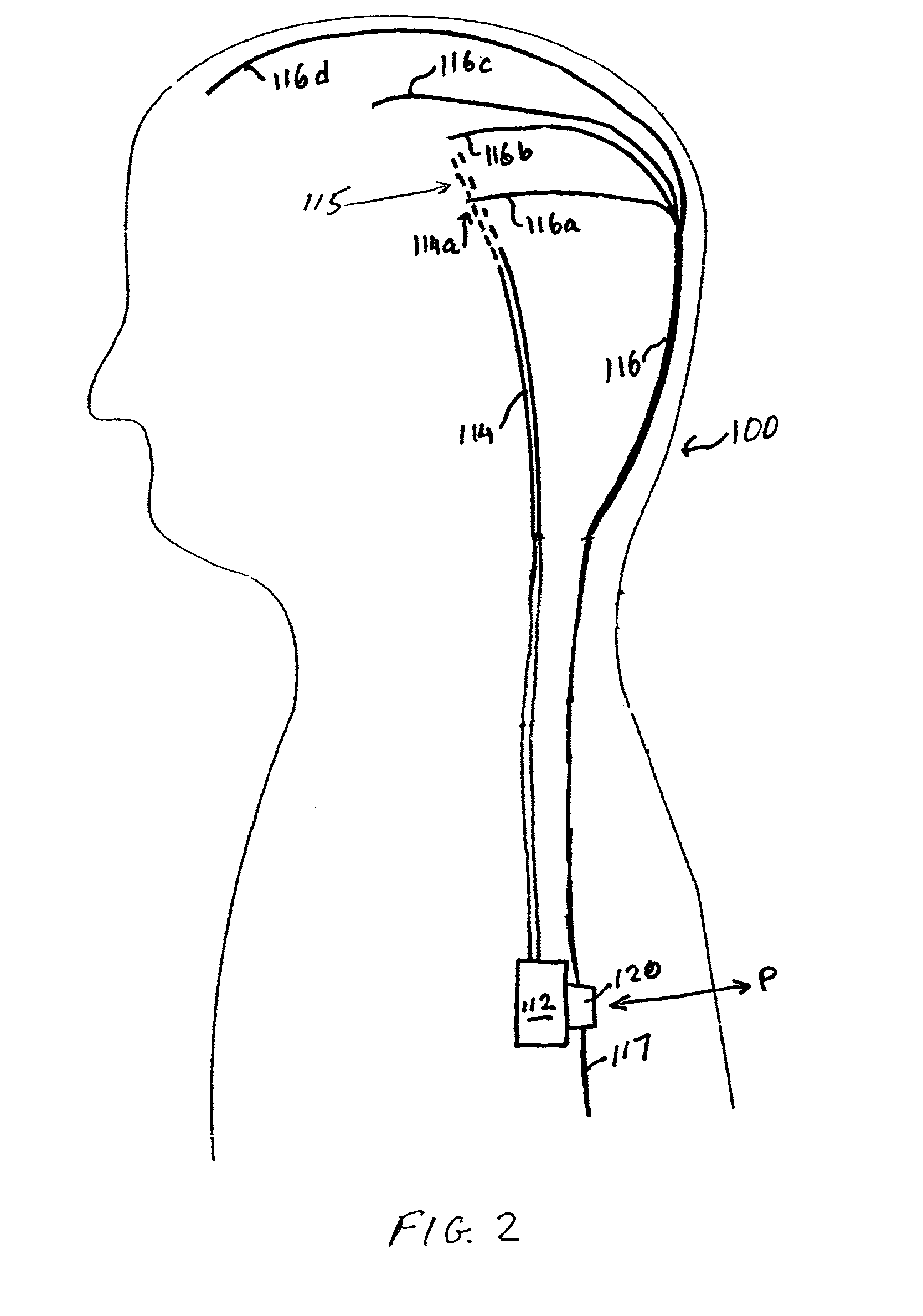[0008]The present invention provides a
drug delivery system that is effective, on a real time basis, to assess primary biochemical parameters and / or events and to deliver one or more drugs to a tissue site, virtually instantaneously, to respond to the detected biochemical parameter. The invention is thus an improved closed-loop
feedback control system that is particularly advantageous in the treatment of disorders of the
central nervous system. Patient safety and well-being are enhanced not only by obviating the need to
expose the patient to electrical circuitry, but also by providing an enhanced therapeutic response to sensed biochemical events.
[0009]The invention provides a significant
advantage in that biologic processes that give rise to treatments involving the system of the invention are dynamic; they vary from individual to individual,
disease to
disease. The need for a particular drug or
biological agent, and the
dose of the agent required, will also vary with changing severity of a
disease. For example, as a patient's health improves, the drug or
biological agent may be metabolized at a faster rate, so a higher
dose would be required. The closed-loop,
biological feedback sensor-based system of the invention enables a
rapid response to be made based on a patient's changing needs.
[0010]The closed-loop feedback
control system of the present invention provides a
delivery system that is at least partly implantable within a subject. The system includes a
drug delivery device, a delivery conduit, one or more biosensors, and a controller unit that may be associated with the drug delivery device. Preferably all components of the system are implanted within a tissue or organ site within a subject's body. In one embodiment the distal or delivery end of the delivery conduit is disposed within tissue of the central or
peripheral nervous system and the
biosensor(s) is disposed in the same tissue or
organ system or within another tissue or
organ system of the patient. The
biosensor(s) can be disposed local to or remote from the delivery end of the delivery conduit. In operation the system monitors one or more biochemical events or parameters and, based on the sensed data, controls the delivery parameters (e.g., flow rate and duration) of one or more drugs housed within the drug delivery device. That is, the
biosensor(s) detects a biochemical event or parameter and conveys a
signal representative of the sensed data to the controller unit. Based on this information, and any pre-programmed or subsequently programmed
operating procedures, the controller unit then instructs the drug delivery device (e.g.,
infusion pump) to deliver one or more drugs at an appropriate flow rate and for an appropriate duration to maintain the sensed parameters within a predetermined, acceptable range. The biosensor(s) continuously monitor the subject to make any adjustments to the drug delivery parameters to maintain the parameters within a predetermined, acceptable range. The sensed parameters can give the physician critical information on the subject's disease state, thus enabling the dosage requirement to be established. The physician can control the drug delivery parameters, and make any future adjustments, based on the information generated by the biosensor(s).
[0014]One embodiment seeks to prevent ischemic damage of central or
peripheral nervous system tissue consequent to trauma, and employs
fiber-based biosensor(s) capable of substantially continuous
polling detection with minimal disruption of the surrounding biological processes. The biosensor(s) provide immediate detection of one or multiple parameters, allowing the
control unit to initiate intervention in cases of trauma, or to adjust or discontinue a treatment before the complexity of metabolic disruption has led to damage or irreversible processes. Another embodiment may manage chronic or
acute pain by localized administration of a highly concentrated
morphine-like pain killer in nervous system tissue. Yet another embodiment may administer material such as a
hormone in a cyclic or varying
regimen, with the
closed loop feedback serving to adjust delivery, with suitable
lag or lead times, to maintain a temporally-varying
set point. Still another embodiment may detect levels of
neurotransmitter or other neurochemical agents, and administer material to control or ameliorate effects of Parkinson's disease or other neurologic or neurodegenerative diseases.
 Login to View More
Login to View More  Login to View More
Login to View More 


